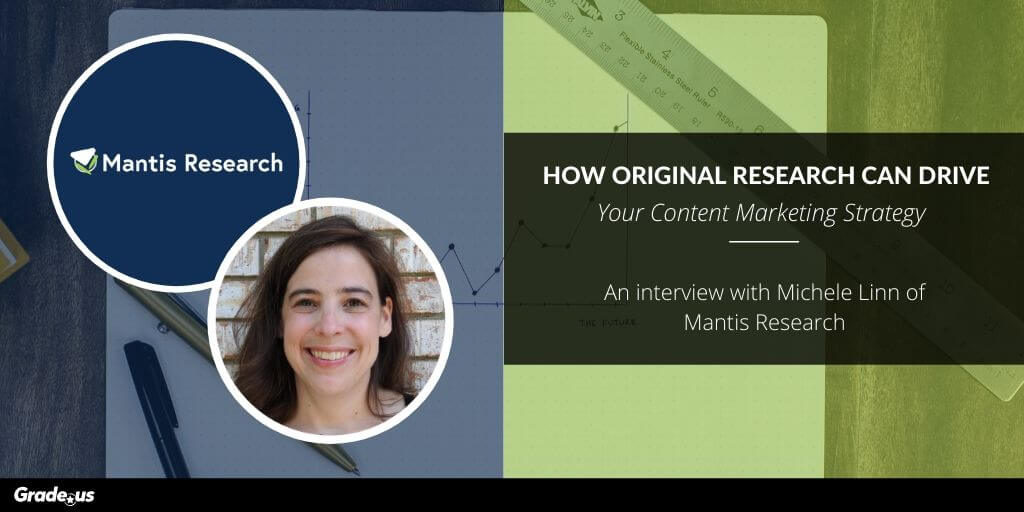Michele Linn is on a mission. She’s all about helping marketers create meaningful content. To Michele, this process often starts with a really well-designed original research project.
She’s the Co-Founder and Chief Strategy Officer at Mantis Research. Her firm is devoted to helping content marketers produce and amplify original research. She’s also the host of the podcast, Marketing Breakout, which is devoted to providing marketers with actionable tips and advice.
“Actionable” is the name of the game when she talks to you, too. If you’ve known for awhile that original research is pretty great, but haven’t had any clue where or how to start, then you won’t want to miss this Q&A.
Why do companies struggle with content marketing?
Raney: A couple of years ago you wrote that companies were still struggling with content marketing. Is that still the case? What’s changed, and what hasn’t?
Michele: I’ve been in the content marketing space for over ten years, and I feel like some of the conversations we had to have back then are conversations we’re still having today.
A lot of it is basics. If you’ve been in this space, you know them, but you might not be doing them. You see a lot of examples of companies not even doing the basics.
Beyond that, even those companies who are talking about their audience, not talking about their products and services or are really doing great content are finding it harder than ever, just because for so many the space is often so saturated.
Raney: What’s the disconnect? What’s the block that’s keeping these companies from doing what they know they should be doing?
Michele: I think honestly there are a lot of different blocks.
I’ve actually done surveys with other companies about this. We’re always doing so many different things. We’re always so reactive in marketing. We have managers who are constantly saying, “let’s do this, let’s try this.” You have these managers who are enamored by the shiny, the new, the different.
And we’re also—and this is a really big stereotype—curious, creative people.
So, I think we often get bored of the path before our prospect gets bored with the path. I feel like we constantly want to be changing, and doing things that are new. It would be really helpful to a lot of people to just stick to the path.
We’re constantly pulled in so many directions and it’s hard to do any one thing really well, but you’ve got to focus on doing one thing really well for an extended period of time.
How should you think about content marketing goals and KPIs?
Raney: Let’s talk about mindset for a minute. To be a good content marketer you have to educate, serve, and give. But you also have this pressure to perform. It’s great to be selfish, but you have to worry about whether you’re moving that needle or not.
So, while it always feels like one should lead effortlessly to the other, that’s not always the case.
How do you feel content marketers should really be thinking about what they need to do when they start feeling the tension between these two needs?
Michele: I think it helps to get on the same page as the person who you’re answering to.
When you say “move the needle” that can mean a lot of different things for a lot of different people, so start there.
Does that mean website traffic is growing? Does that mean you’re getting backlinks from sites that have great domain authority? Does that mean you’re building your subscriber list? Getting leads?
Figure out what’s actually meaningful first, then track that.
Raney: Which of those metrics do you tend to favor, or encourage people to focus on?
Michele: Honestly, most marketers I’ve talked to can’t attribute content marketing to sales. That’s a really hard thing to try to do.
Back in the day I used to work for Content Marketing Institute.
Joe was a fabulous, fabulous boss, because he had singular focus. We were always focused on email subscribers, so I think that’s a really important metric for marketers to focus on. Getting them, and keeping them.
Still, just because I think that’s a good metric doesn’t mean it’s a good metric for every company. I think different people have different needs.
Honestly, it’s going to depend on what that company needs.
Right now, a lot of what I’m doing is helping marketers publish original research. Granted, that’s a very specific thing, but by and large most people aren’t publishing research to increase their email subscribers. They’re primarily doing it for leads or backlinks, or they’re trying to get their names out there and be a thought leader in the space.
How do you invest in research for your content marketing?
Raney: I’m glad you brought up original research, because I was going to go there next. How do you recommend getting started, especially if you are dealing with a company or person who would like to do original research, but doesn’t really have a lot of resources to work with?
Michele: So, if they don’t have people resources, but do have financial resources, I definitely recommend they look for help.
Doing research is a really nuanced thing. There are a lot of different parts of the process.
You not only need someone who understands how to get really credible data, but you also need someone who understands how to make that data tell an actual story that’s useful and compelling.
If you don’t have people resources, I absolutely recommend that you get help.
If the issue is people and money? You’ve got to be realistic about the time it’s going to take you to do it. I think you mentioned you’d spoken to Andy Crestodina in the past?
Raney: I did.
Michele: Andy does original research too, and he had this great quote I use often. He said, “Original research will produce 100 times the results of a regular article, but takes 10 times the amount of time to produce.”
So, I think you really need to go into it with an appetite to spend that time or to do it well. If you don’t have it, I would try to do something a little quicker.
There’s different types of research you can do, and not all of them take as long as a big benchmarking study.
Raney: Let’s talk about those different types. Can you break them down for our readers?
Michele: A really common type of research that marketers do is they’ll do what I like to call a traditional benchmarking report.
If your readers follow Content Marketing Institute then they’ll know they’ve done a benchmark study since 2010 about the state of content marketing. They cover the state of the industry. They go survey marketers to really understand what’s going on.
Then they have fodder for different story ideas. That’s a big, traditional project that can take a lot of time to do, but marketers who are just interested in getting press mentions could do a short poll, and can work with a PR person to find out what’s timely and interesting to journalists.
You can have that person reach out to journalists to see what’s interesting to them about your particular topic and do something that’s punchy, fun, or controversial.
Another thing Andy talks about is observational research. He had a blog post on his website and he asked the question: “are web design standards actually standard? He looked at ten different web design standards, and he had a virtual assistant track whether these websites adhered to each of those standards.
So that’s new data out in the marketplace, which is a lot easier to get than relying on survey data.
Another thing you can do is use US Census data. There’s tons of different data sources you can pull from, and you can tell stories from it.
I always use Brand Cafe as an example. They do a great job with that type of data. If you’re a company that happens to have a lot of internal data you can tell stories out of that, too.
Raney: What would you say to someone who doesn’t feel very confident in their ability to do that kind of data science? To someone who struggles with numbers, statistics, or even the correct way to gather the data?
Michele: Honestly, I would say get help.
I have a business partner and she does a really great job of unearthing the stories buried in a customer’s internal data. I would never take that work on my own because I just don’t have the head for it. It’s a very different way of thinking.
Honestly, I would tell marketers to look at their particular strengths and figure out what they are good at. Then do that type of research.
How can you take your research to the next level?
Raney: Have you ever had a project where you looked back and realized you’d done something that skewed the results?
Michele: I don’t know if I’d ever say I produced skewed results. I have definitely had projects where they didn’t give us anything useful.
Still, you have to be really cognizant. Sometimes when we do surveys, we work with panel companies. We go through and we manually clean that data. We typically go back to the polling company and ask them to refresh some of the responses.
You have to set up the panel so you make sure you’re getting good responses. Then you have to clean it. Chances are you’re still going to have to disqualify some of those responses. But if you go through all the data quality steps it won’t be skewed. It may just be less useful than what you needed it to be.
Raney: What do you mean by cleaning it, and data quality?
Michele: There’s lots of little things you can do.
Let’s say you use a panel to get responses. We will always ask open-ended questions. If there’s any jibberish in those answers chances are their answers aren’t good. The big three problems with survey responses is that they’re either speeding through and not reading questions carefully, or they’re not giving you good, valid data.
Bots are another issue, and people just trying to qualify to get a particular incentive. You have to set things up so people don’t feel like they have to answer a certain way to qualify for that incentive.
What does content marketing look like in 2020?
Raney: Finally, it’s that time of year again. What do you think content marketers and researchers should be thinking about as we head into 2020?
Michele: Data quality. It’s becoming increasingly difficult. I don’t know how many marketers are rigorously cleaning their data to think about bias in responses.
They should also be thinking about telling a compelling story. You can use the research you have to uncover something new that people didn’t know happened, or validate people’s thinking with data so they actually take actions. Or you can uncover opportunities, find things people could be doing better.
Finally, I recommend people do more with their findings. Research is a long process. Many marketers are kind of over it before the study is done. Then they’re onto the next thing.
But you have so much data there. And there are so many different stories and so many different ways to spin off stories.
Marketers who create at least six pieces of content from their research are having more success than their peers, so we always recommend doing six things. Like one blog post, one guest post, one webinar, one infographic, one webinar, one ebook. Then do a little extra to get your research out there.










